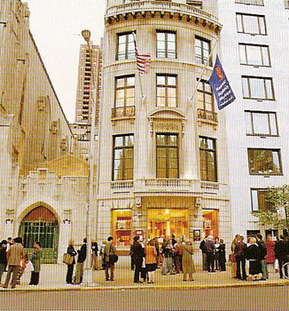Let’s turn the page on the National Academy Museum (below). As the art world — no, make that the museum world — will remember, it was sanctioned by the Association of Art Museum Directors a few years back for deaccessioning two Hudson River School paintings to make ends meet. A short time later — but not short enough for the NAM — the sanctions were lifted.
 This weekend, after being closed for a renovations, the NAM reopens with six exhibitions, and all seems to be well.
This weekend, after being closed for a renovations, the NAM reopens with six exhibitions, and all seems to be well.
Or does it?
In tomorrow’s Wall Street Journal, I discuss the issues with Carmine Branagan, the director. Aside from balancing the budget, which will take several years, she says, the main issues are two:
-
In a city loaded with museums, what niche exists for hers?
-
And, in the 21st century, what artists want to belong to an academy?
The Academy can elect up to 450 members, but it has only 320.
Recently, as the article says, the Academy has opened up its membership to go beyond painters, sculptors, graphic artists and architects — it may now admit any kind of visual artist, including those working in new media and installations.
So although many member abstained from the vote on that change, which you will see in the article, Branagan has succeeded in making a substantive change there.
The niche is a big problem. Before the renovation, the NAM was attracting 20,000 people a year — very low in NYC. Branagan has purposely set the bar low, hoping for only a 20% increase in the next three years.
It’s smart to avoid raising expectations. I reserve judgement on the current exhibitions:
-
An American Collection, which provides an overview of the colletion up to 1970, about 100 paintingshung salon-style.
-
A retrospective for Will Barnet, who was elected to the Academy in 1982 and turned 100 in May.
-
The Artist Revealed: A Panorama of Great Artist Portraits, which should be a strength, because by tradition each member donates a work to the Academy and many gave portraits – including Thomas Eakins, whose only fully realized self-portrait will be on view.
-
An architecture display highlighting post-war drawings, models and photographs by the likes of Eero Saarinen and I.M. Pei
-
Recent works of five members, including Elizabeth Catlett and Malcolm Morley
-
A show of works made since 2000.
I haven’t seen them. But I hope they’re good, giving the Academy a jumpstart. It’s going to need it.

 him explaining his decision to use a lot of glass in the museum’s new American wing with the line, “so people outside can see people inside and know you don’t have to wear black tie to come in.” As he pointed out, most people see museum directors and patrons in those society pictures taken at fund-raising galas, when they are all dressed to the nines.
him explaining his decision to use a lot of glass in the museum’s new American wing with the line, “so people outside can see people inside and know you don’t have to wear black tie to come in.” As he pointed out, most people see museum directors and patrons in those society pictures taken at fund-raising galas, when they are all dressed to the nines. When I talk with directors, some say they are already visible in the community. One told me he was out virtually every night — often courting donors. That’s a tough, important job, but it’s not their only job, and they might even like the relief of being with regular people.
When I talk with directors, some say they are already visible in the community. One told me he was out virtually every night — often courting donors. That’s a tough, important job, but it’s not their only job, and they might even like the relief of being with regular people. -thumb-175x175-20502.jpg)
 The other day I ran across
The other day I ran across ![Thumbnail image for Photo_by_Kertis_Creative.[1].jpg](http://www.artsjournal.com/realcleararts/assets_c/2011/09/Photo_by_Kertis_Creative.[1]-thumb-480x319-20505.jpg) The story adds
The story adds